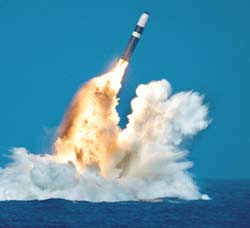US forgets how to manufacture Trident missile warhead component
By Defence Bureau | 10 Mar 2009
Joint American-British plans to upgrade the Trident nuclear weapons had to be temporarily stalled as the US scientific establishment either forgot how to manufacture, or mislaid blue prints of a critical component, an investigation by a US Congressional watchdog body has revealed.
 A Government Accountability Office (GAO) report said that the US National Nuclear Security Administration (NNSA) "lost knowledge" of how to make a little known, but very hazardous material, codenamed Fogbank. This oversight resulted in the warhead upgrade programme being put back by at least a year, and cost the taxpayer an extra $69 million.
A Government Accountability Office (GAO) report said that the US National Nuclear Security Administration (NNSA) "lost knowledge" of how to make a little known, but very hazardous material, codenamed Fogbank. This oversight resulted in the warhead upgrade programme being put back by at least a year, and cost the taxpayer an extra $69 million.
The Trident missile is a multiple independently targetable re-entry vehicle (MIRV) submarine-launched ballistic missile (SLBM) designed by American defence contractor, Lockheed Martin Space Systems. The Trident is armed with nuclear warheads and is launched from nuclear-powered ballistic missile submarines.
Trident missiles are carried by fourteen active US Navy Ohio class submarines, with US-designed warheads, and four Royal Navy Vanguard class submarines, with British warheads.
The US and the UK are trying to upgrade the ageing W76 warheads that arm the Trident missiles in order to prolong their life, and ensure safety and reliability. The upgrade requires that the mysterious material Fogbank be replaced.
Nothing is known about the nature, or function, of Fogbank. But existing material on the topic describes it as a likely 'interstage' between the fission and fusion stages of a thermonuclear bomb. In physical nature it could be some kind of foam, or an aerogel.
In Congressional hearings US officials have let it be known that manufacturing the material requires a solvent cleaning agent which is "extremely flammable" and "explosive". The process also involves dealing with "toxic materials" hazardous to workers.
An unclassified version of the GAO report on the subject was released last week. The report concluded: "NNSA did not effectively manage one of the highest risks of the programme - the manufacture of a key material known as Fogbank - resulting in $69 million in cost over-runs and a schedule delay of at least one year that presented significant logistical challenges for the navy."
The report pointed out that a new production facility was set up at the Y-12 National Security Complex at Oak Ridge, Tennessee, because an old one had been demolished in the 1990s.
Interestingly, it said vital information on how Fogbank was actually manufactured was somehow mislaid. "NNSA had lost knowledge of how to manufacture the material because it had kept few records of the process when the material was made in the 1980s, and almost all staff with expertise on production had retired or left the agency," the report said.
The NNSA's principal deputy administrator, William Ostendorff, said that the agency "generally agrees" with the findings of the GAO report.




















